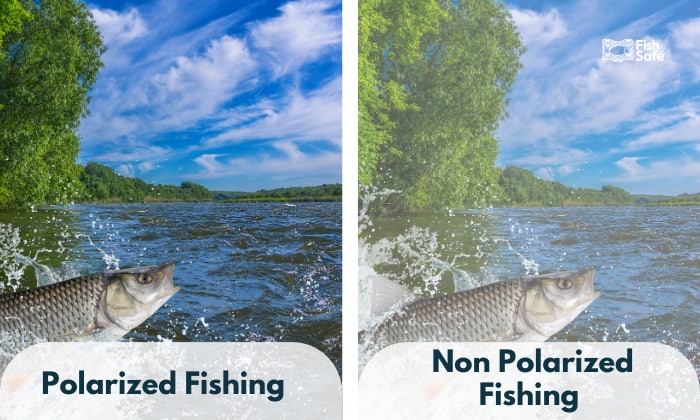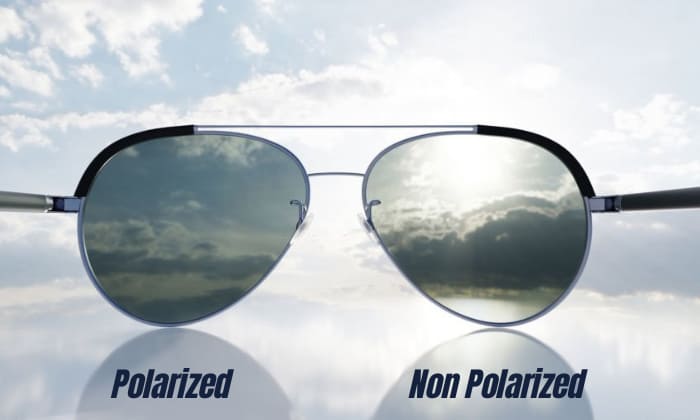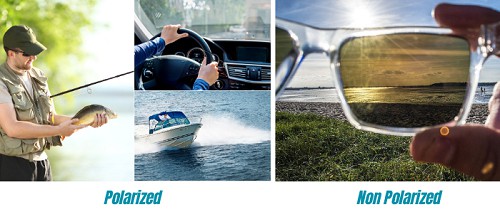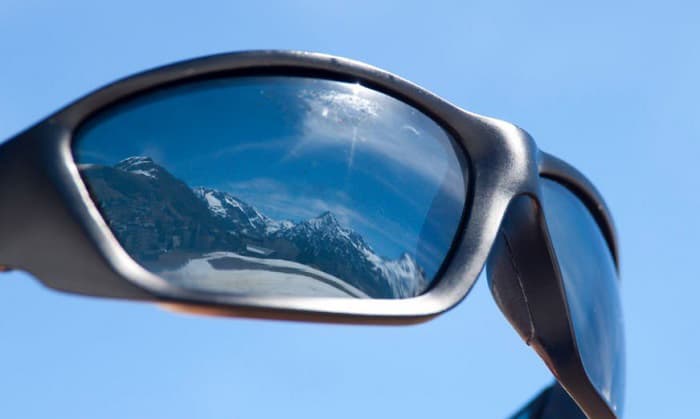Polarized and non polarized lenses are two different types of eyewear that are commonly used for fishing. Although they serve different purposes, they also offer unique benefits. However, their main difference lies in their ability to reduce glare.
In this blog post, you will learn the similarities, differences, pros, and cons of polarized vs non polarized lenses for fishing. The table below will give you an overview of these fishing essentials, so keep reading!
| Aspect | Polarized | Non Polarized |
| Lens | Has a polarizing filter | Does not have a polarizing filter |
| Glare Reduction | Efficient in reducing glare | Slight to no reduction of glare |
| UV Protection | Does not provide protection from UV unless labeled as such | Generally provides protection from UV |
| Color Perception | May slightly alter color perception | Alters color perception |
| Price Range | Generally expensive | Generally cheaper |
Page Contents
Overview of Polarized Versus Non Polarized Lenses
1. Non-polarized lenses
Non-polarized lenses for fishing are tinted eyeglasses that minimize eye strain and provide protection against harmful UV rays by blocking intense light. They are effective in reducing sun glare, though, not eliminating it entirely.
Furthermore, with non-polaized glasses, fishers can read LED screens or GPS devices just fine, unlike with polarized ones.
2. About polarized lenses
The polarized definition of glare reduction is the ability to eliminate horizontal light from surfaces, and polarized lenses can do just that!
Polarized lenses contain a filter that blocks horizontal light from reflective flat surfaces like water and snow. This filter is a chemical film applied to the surface of the lenses. It is like a window blind that only allows vertical light.
This feature of polarized sunglasses results in clearer vision and reduced eye strain. Therefore, this type of eyeglasses is ideal for fishing, driving, golfing, and boating.
Similarities
These glasses are available in a diverse array of styles and designs to meet our requirements.
More importantly, non-polarized and polarized sunglasses are capable of reducing the strain on the eyes that comes from strong light sources. They are critical equipment when we go fishing for long hours under the sunlight.
Furthermore, whether you have normal vision or require prescription lenses, you can wear these sunglasses with good eye comfort and clarity.
Furthermore, they are indeed versatile eyewear, made for various outdoor activities, including driving, sports, or leisure activities.
Difference Between Polarized and Non Polarized Fishing Sunglasses
1. Glare reduction
Unlike non-polarized lenses, polarized lenses contain a filter to block horizontally polarized light from surfaces. This feature effectively reduces glare and allows the wearer to see clearly with less eye strain.
2. Light transmission
Polarized lenses may reduce overall light transmission, making it hard for anglers to see in low-light conditions.
Meanwhile, non-polarized lenses allow all types of light waves to pass through uniformly, maintaining the original brightness of the surrounding environment.
Furthermore, you can still see the billboard electronic displays or your phone screens and other gadgets’ screens just fine with non-polarized glasses.
3. Outdoor activities
Polarized lenses are highly recommended for fishing, boating, and driving. However, they are not recommended for skiing because they reduce glare from ice, which can lead to mishaps.
Meanwhile, non-polarized lenses may be used for general outdoor activities where glare reduction is not the primary concern.
4. Price
You can get a decent pair of polarized or non-polarized sunglasses at $20 – $50. At this price, they feature UV blocker film and tint for good eye comfort. Indeed, many products go as high as $100 – $200, all depending on the quality of lens and frame.
Which is Better Lenses?
Polarized lenses are capable of reducing glare and enhancing visibility by blocking reflection from horizontal surfaces. Most anglers prefer these types of sunglasses because they enable them to see and spot fish with greater ease.
It is worth noting that this advantage is particularly valuable when fishing in bright conditions. They make the wearer’s vision darker but clearer.
Meanwhile, non polarized lenses are more suitable in overcast or low-light conditions, where glare is less of a concern.
The choice between polarized versus non polarized lenses for fishing should be made by considering different factors, such as the specific weather and lighting conditions at the time.
Pros and Cons
1. Polarized Fishing Sunglasses
- Glare reduction is the main benefit of polarized sunglasses.
- Best fishing glasses to see fish in water because they improve color contrast and clarity. They provide anglers with a clearer view of underwater structures, vegetation, and fish movements.
- Polarized sunglasses also reduce eye strain for anglers.
- Polarized lenses may reduce overall visibility in low-light situations or when fishing in heavily shaded areas.
- Polarized lenses can interfere with the visibility of LCD screens, such as those on fish finders or digital displays on fishing equipment.
- Polarized lenses eliminate glare when skiing or driving on icy roads.
2. Non Polarized Fishing Sunglasses
- Non polarized fishing sunglasses allow more light to pass through for anglers to see fish underwater in low-light environments or during dawn and dusk periods.
- Non-polarized lenses do not interfere with the visibility of digital screens.
- Do not eliminate glare completely
Recommended fishing sunglasses brands
- Costa Del Mar
- Oakley
- Maui Jim
- Smith Optics
- Wiley X
How to do a polarized sunglasses test?
You might want to test if the bought sunglasses are indeed polarized by following these tips:
- Hold the glasses 10 cm from your face, tilt, and gaze toward a reflective surface. If the glare from the light source is reduced, it’s a polarized lens.
- Wear two sunglasses at the same time. You can tell one pair is polarized if you see through it just fine, without eye discomfort and glare.
- Look at an LCD screen while wearing your glasses. They are polarized if your sight becomes dim.
- The polarized glasses often have a dark sticker on one of its lense, so you can title the pair about 60 degrees and see if the dark spot appears.
Conclusion
The majority of anglers prefer anti-glare lenses because they can lessen glare, improve clarity, and ease eye strain in bright environments. However, they may affect the visibility of digital screens and are not suitable for dark conditions.
Meanwhile, non polarized lenses provide UV protection and are suitable for everyday wear. They maintain the brightness of the wearer’s vision, but these types of sunglasses cannot eliminate glare.
Choosing between polarized vs non polarized fishing lenses will depend on individual needs. For glare reduction and enhanced clarity, polarized lenses are recommended. For versatility and UV protection, non-polarized lenses are practical.

Hi, I’m Thomas Kirk. As someone who loves fishing, I am here to offer everyone help on all aspects of angling, whether it’s preparing live bait or determining when to crank in a fish. As you go through the guides here, feel free to let us know your thoughts and any topics you want to learn more about.









